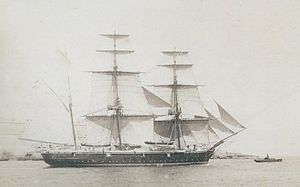HMS Hornet was a 17-gun wooden screw sloop of the Cruizer class of the Royal Navy, launched in 1854 and broken up in 1868.
 Hornet's sister ship, Cruizer, shown at Malta in 1894.
| |
| History | |
|---|---|
| Name | Hornet |
| Ordered | 1 November 1850[2] |
| Builder | Royal Dockyard, Deptford |
| Cost | £29,142[2] |
| Launched | 13 April 1854[1] |
| Commissioned | 14 July 1854[2] |
| Fate | Broken up 1868 |
| General characteristics | |
| Class and type | Cruizer-class screw sloop |
| Displacement | 1,045 tons [2] |
| Tons burthen | 747+51⁄94 bm[2] |
| Length |
|
| Beam | 31 ft 10 in (9.70 m)[2] |
| Depth of hold | 17 ft 6 in (5.33 m)[2] |
| Installed power |
|
| Propulsion |
|
| Sail plan | Barque-rigged |
| Speed | 7.75 knots (14.35 km/h; 8.92 mph) |
| Armament |
|
Construction edit
Originally ordered in April 1847 as a "Screw Schooner", she was suspended in August 1847 and re-ordered on 1 November 1850 to the same design as HMS Cruizer. The wooden sloops of the Cruizer class were designed under the direction of Lord John Hay, and after his "Committee of Reference" was disbanded, their construction was supervised by the new Surveyor of the Navy, Sir Baldwin Walker. Hornet was laid down at the Royal Dockyard, Deptford in June 1851. Her two-cylinder horizontal single-expansion steam engine, which was supplied by James Watt & Company at a cost of £5,450, generated an indicated horsepower of 233 hp (174 kW); driving a single screw, this gave a maximum speed of 7.75 knots (14.35 km/h; 8.92 mph). The class was given a barque-rig sail plan.
Armament edit
All the ships of the class were provided with one 32-pounder (56 cwt) long gun on a pivot mount and sixteen 32-pounder (32 cwt) carriage guns in a broadside arrangement.
History edit
Hornet served in the Baltic in 1854 during the Crimean War, and from 1854 until 1859 she served in the East Indies and in China, taking part in the Second Opium War. After a refit in 1859–1860 she recommissioned for the Cape of Good Hope Station and served both there and on the East Indies Station.
The Russian War (1854) edit
Under Commander Frederick Archibald Campbell[3] Hornet served in the Baltic campaign of 1854 during the Russian War.
The East Indies and China Stations (1854 - 1856) edit
On 25 April 1855 Hornet, along with HMS Sybille and HMS Bittern, under Commodore The Hon. Charles Elliot discovered Liancourt Rocks in the Sea of Japan, at 37°14′22″N 131°52′10″E / 37.23944°N 131.86944°E. It was about a mile in extent, running in a NW by W and SE by E direction and formed together by a reef of rocks.[1] The Hornet's commander at the time, Charles Codrington Forsyth, noted in the ship's log:
We could discern no dangers lying off them and the waters appear to be deep close to the shore. They are barren, without exception of a few patches of grass on their sides and landing would be difficult except in very calm weather. The height of the NW island was ascertained to be 410 ft above sea level
The Second Opium War (1856 - 1859) edit
On 12 November 1856, in company with Calcutta, Nankin, Encounter, Barracouta and Coromandel, she bombarded and captured the Bogue forts and the next day, the Anunghoy forts.[4] Christmas 1856 was spent as Guardship at Canton (now Guangzhou). In 1857 she spent much of her time at Hong Kong and in the Canton River, culminating in the capture of Canton on 28 December 1857 under Rear-Admiral Sir Michael Seymour.[5][6] In February 1859 she sailed for England, decommissioning in Portsmouth on 14 July 1859.[1]
The Cape of Good Hope and East Indies Stations (1860 - 1864) edit
On 20 July 1860 Hornet recommissioned for service on the Cape of Good Hope Station under Commander William Buller Fullerton Elphinstone.[1] She also served during this period on the East Indies Station.[3]
Disposal edit
Hornet decommissioned at Portsmouth on 22 September 1864 and was broken up by White of Cowes in 1868.
Commanding officers edit
| From | To | Captain |
|---|---|---|
| 15 May 1854 | 13 September 1854 | Commander Frederick Archibald Campbell[3] |
| 13 September 1854 | 1857? | Commander Charles Codrington Forsyth[3] |
| January 1857 | 26 February 1858 | Commander William Dowell[3] |
| 26 February 1858 | 14 July 1859 | Commander Lord Gilford[3] |
| 14 July 1859 | 20 July 1860 | Out of Commission (Portsmouth) |
| 20 July 1860 | 3 May 1861 | Commander William Buller Fullerton Elphinstone[3] |
| 3 May 1861 | 1864? | Commander Joseph Dayman[3] |
| 1864? | 12 September 1864 | Acting Commander Richard Hare[3] |
| 12 September 1864 | Out of Commission (Portsmouth) |
Citations edit
- ^ a b c d "HMS Hornet at Naval Database website". Retrieved 15 November 2008.
- ^ a b c d e f g h i Winfield (2004) pp.213-215
- ^ a b c d e f g h i "HMS Hornet at William Looney RN website". Retrieved 15 November 2008.
- ^ Hurrah for the Life of a Sailor by Vice-Admiral Sir William R Kennedy KCB, William Blackwood and Sons, Edinburgh, 1900
- ^ The London Gazette, 16 February 1858, p.4
- ^ The London Gazette, 26 February 1858
References edit
- Winfield, R.; Lyon, D. (2004). The Sail and Steam Navy List: All the Ships of the Royal Navy 1815–1889. London: Chatham Publishing. ISBN 978-1-86176-032-6. OCLC 52620555.
External links edit
- Media related to HMS Hornet (ship, 1854) at Wikimedia Commons